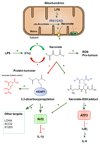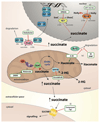Coupling Krebs cycle metabolites to signalling in immunity and cancer
- PMID: 31032474
- PMCID: PMC6485344
- DOI: 10.1038/s42255-018-0014-7
Coupling Krebs cycle metabolites to signalling in immunity and cancer
Abstract
Metabolic reprogramming has become a key focus for both immunologists and cancer biologists, with exciting advances providing new insights into underlying mechanisms of disease. Metabolites traditionally associated with bioenergetics or biosynthesis have been implicated in immunity and malignancy in transformed cells, with a particular focus on intermediates of the mitochondrial pathway known as the Krebs cycle. Among these, the intermediates succinate, fumarate, itaconate, 2-hydroxyglutarate isomers (D-2-hydroxyglutarate and L-2-hydroxyglutarate) and acetyl-CoA now have extensive evidence for "non-metabolic" signalling functions in both physiological immune contexts and in disease contexts, such as the initiation of carcinogenesis. This review will describe how metabolic reprogramming, with emphasis placed on these metabolites, leads to altered immune cell and transformed cell function. The latest findings are informative for new therapeutic approaches which could be transformative for a range of diseases.
Figures






References
Publication types
MeSH terms
Substances
Grants and funding
LinkOut - more resources
Full Text Sources
Other Literature Sources

